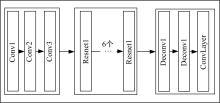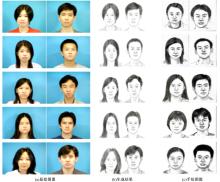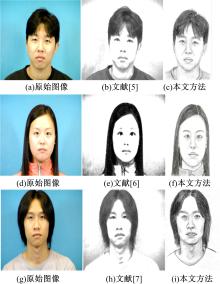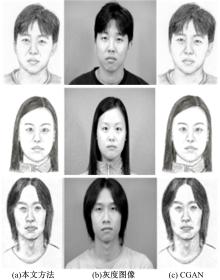吉林大学学报(工学版) ›› 2021, Vol. 51 ›› Issue (1): 285-292.doi: 10.13229/j.cnki.jdxbgxb20190831
• 计算机科学与技术 • 上一篇
基于生成对抗网络的人脸铅笔画算法
- 哈尔滨理工大学 计算机科学与技术学院,哈尔滨 150080
Face pencil drawing algorithms based on generative adversarial network
Xiao-yu WANG( ),Xin-hao HU,Chang-lin HAN
),Xin-hao HU,Chang-lin HAN
- School of Computer Science and Technology,Harbin University of Science and Technology,Harbin 150080,China
摘要:
传统的铅笔画绘制技术主要是基于对笔画方向、粗细、长短和纹理的模拟,生成结果生硬单一,并且缺少艺术感。为了使铅笔画生成结果更加具有艺术感,同时能够保留原始人脸图像的结构,提出了一种利用生成对抗网络将真实人脸图像转换成具有铅笔画风格图像的方法。生成网络利用卷积生成具有铅笔画效果的人脸图像,对抗网络用于学习艺术家真实手绘的人脸铅笔画分布,并且优化了距离偏差,加入了细节控制损失。实验结果表明,该方法生成的人脸铅笔画图像风格更加灵活,更加具有艺术感。
中图分类号:
- TP391.4
| 1 | Strassmann S. Hairy brushes[J]. Computer Graphics, 1986, 20(4): 225-232. |
| 2 | Sasada T T. Drawing natural scenery by computergraphics[J]. Computer-Aided Design, 1987, 19(4): 212-218. |
| 3 | Sousa M C, Buchanan J W. Observational model of blenders and erasers in computer-generated pencil rendering[C]∥Proceedings of Conference on Graphics Interface, Morgan Kaufmann Publishers Inc., San Francisco, United States,1999: 157-166. |
| 4 | Mao X, Nagasaka Y, Imamiya A. Automatic generation of pencil drawing from 2D images using line integral convolution[C]∥Proceedings of the 7th International Conference on Computer Aided Design and Computer Graphics,Kunming,China,2001: 240-248. |
| 5 | Lu C, Xu L, Jia J. Combining sketch and tone for pencil drawing production[C]∥ Eurographics Association,Cagliari, Sardinia, Italy, 2012: 65-73. |
| 6 | 孙玉红, 张元科, 孟静. 基于纹理和草图的图像铅笔画绘制[J]. 计算机应用, 2016,36(7): 1976-1980. |
| Sun Yu-hong, Zhang Yuan-ke, Meng Jing. Pencil drawing rendering based on textures and sketches[J]. Journal of Computer Applications, 2016, 36(7): 1976-1980. | |
| 7 | 王权, 胡越黎, 燕明, 等. 基于混合梯度最小化的铅笔画生成[J]. 上海大学学报:自然科学版, 2018, 24(2): 314-321. |
| Wang Quan, Hu Yue-li, Yan Ming, et al. Pencil drawing production based on hybrid gradient minimization[J]. Journal of Shanghai University (Natural Science Edition), 2018, 24(2): 314-321. | |
| 8 | Goodfellow I J, Pouget-Abadie J, Mirza M, et al. Generative adversarial nets[C]∥ International Conference on Neural Information Processing Systems, Montreal, Canada, 2014: 2672-2680. |
| 9 | Ledig C, Theis L, Huszar F, et al. Photo realistic single image super-resolution using a generative adversarial network[C]∥IEEE Conference on Computer Vision and Pattern Recognition(CVPR), Honolulu, USA, 2017: 4681-4690. |
| 10 | Shelhamer E, Long J, Darrell T. Fully convolutional networks for semantic segmentation[J]. IEEE Transactions on Pattern Analysis & Machine Intelligence, 2017, 39(4): 640-651. |
| 11 | Reed S, Akata Z, Yan X, et al. Generative adversarial text to image synthesis[C]∥International Conference on International Conference on Machine Learning, Dubai, UAE,2016: 1060-1069. |
| 12 | 曹志义, 牛少彰, 张继威. 基于生成对抗网络的遮挡图像修复算法[J]. 北京邮电大学学报, 2018, 41(3): 81-86. |
| Cao Zhi-yi, Niu Shao-zhang, Zhang Ji-wei. Masked image inpainting algorithm based on generative adversarial nets[J]. Journal of Beijing University of Posts and Telecommunications, 2018, 41(3): 81-86. | |
| 13 | Arjovsky M, Chintala S, Bottou L. Wasserstein GAN[EB/OL].[2019-06-26]. arXiv preprint arXiv:1701.07875,2017. |
| 14 | Gulrajani I, Ahmed F, Arjovsky M, et al. Improved training of wasserstein GANs[C]∥Advances in Neural Information Processing Systems,Longbeach,USA,2017: 5769-5779. |
| 15 | Yoshida Y, Miyato T. Spectral norm regularization for improving the generalizability of deep learning[EB/OL].[2019-06-26].arXiv preprint arXiv:1705.10941, 2017. |
| 16 | Kalman D. A singularly valuable decomposition: the SVD of a matrix[J]. The College Mathematics Journal, 1996, 27(1): 2-23. |
| 17 | 王佰玲, 田志宏, 张永铮. 奇异值分解算法优化[J]. 电子学报, 2010, 38(10): 2234-2239. |
| Wang Bai-ling, Tian Zhi-hong, Zhang Yong-zheng. Optimization of singular vector decomposition algorithm[J]. Acta Electronica Sinica, 2010, 38(10): 2234-2239. | |
| 18 | 王功鹏, 段萌, 牛常勇. 基于卷积神经网络的随机梯度下降算法[J]. 计算机工程与设计, 2018, 39(2): 441-445, 462. |
| Wang Gong-peng, Duan Meng, Niu Chang-yong. Stochastic gradient descent algorithm based on convolution neural network[J]. Computer Engineering and Design, 2018, 39(2): 441-445, 462. | |
| 19 | Zhu J Y, Park T, Isola P, et al. Unpaired image-to-image translation using cycle-consistent adversarial networks[C]∥ IEEE International Conference on Computer Vision (ICCV), Venice, Italy, 2017:2223-2232. |
| 20 | 冀中, 刘青, 聂林红,等. 基于卷积神经网络的纹理分类方法研究[J]. 计算机科学与探索, 2016, 10(3):389-397. |
| Ji Zhong, Liu Qing, Nie Lin-hong, et al. Texture classification with convolutional neural network[J]. Journal of Frontiers of Computer Science & Technology, 2016, 10(3): 389-397. | |
| 21 | Simonyan K, Zisserman A. Very deep convolutional networks for large-scale image recognition[C]∥The 3rd International Conference on Learning Representations, Banff, Canada, 2015. |
| 22 | Yamins D L K, Hong H, Cadieu C F, et al. Performance-optimized hierarchical models predict neural responses in higher visual cortex[J]. Proceedings of the National Academy of Sciences of the United States of America, 2014, 111(23): 8619-8624. |
| [1] | 史再峰,李金卓,曹清洁,李慧龙,胡起星. 基于生成对抗网络的低剂量能谱层析成像去噪算法[J]. 吉林大学学报(工学版), 2020, 50(5): 1755-1764. |
| [2] | 周炳海,何朝旭. 基于线边集成超市的混流装配线动态物料配送调度[J]. 吉林大学学报(工学版), 2020, 50(5): 1809-1817. |
| [3] | 蒋磊,管仁初. 基于多目标进化算法的人才质量模糊综合评价系统设计[J]. 吉林大学学报(工学版), 2020, 50(5): 1856-1861. |
| [4] | 李阳,李硕,井丽巍. 基于贝叶斯模型与机器学习算法的金融风险网络评估模型[J]. 吉林大学学报(工学版), 2020, 50(5): 1862-1869. |
| [5] | 赵宏伟,刘晓涵,张媛,范丽丽,龙曼丽,臧雪柏. 基于关键点注意力和通道注意力的服装分类算法[J]. 吉林大学学报(工学版), 2020, 50(5): 1765-1770. |
| [6] | 管乃彦,郭娟利. 基于姿态估计算法的组件感知自适应模型[J]. 吉林大学学报(工学版), 2020, 50(5): 1850-1855. |
| [7] | 车翔玖,董有政. 基于多尺度信息融合的图像识别改进算法[J]. 吉林大学学报(工学版), 2020, 50(5): 1747-1754. |
| [8] | 刘洲洲,尹文晓,张倩昀,彭寒. 基于离散优化算法和机器学习的传感云入侵检测[J]. 吉林大学学报(工学版), 2020, 50(2): 692-702. |
| [9] | 王晓辉,吴禄慎,陈华伟. 基于法向量距离分类的散乱点云数据去噪[J]. 吉林大学学报(工学版), 2020, 50(1): 278-288. |
| [10] | 张笑东,夏筱筠,吕海峰,公绪超,廉梦佳. 大数据网络并行计算环境中生理数据流动态负载均衡[J]. 吉林大学学报(工学版), 2020, 50(1): 247-254. |
| [11] | 金顺福,郄修尘,武海星,霍占强. 基于新型休眠模式的云虚拟机分簇调度策略及性能优化[J]. 吉林大学学报(工学版), 2020, 50(1): 237-246. |
| [12] | 陈蔓,钟勇,李振东. 隐低秩结合低秩表示的多聚焦图像融合[J]. 吉林大学学报(工学版), 2020, 50(1): 297-305. |
| [13] | 邓钧忆,刘衍珩,冯时,赵荣村,王健. 基于GSPN的Ad⁃hoc网络性能和安全平衡[J]. 吉林大学学报(工学版), 2020, 50(1): 255-261. |
| [14] | 王铁君,王维兰. 基于本体的唐卡图像标注方法[J]. 吉林大学学报(工学版), 2020, 50(1): 289-296. |
| [15] | 李雄飞,王婧,张小利,范铁虎. 基于SVM和窗口梯度的多焦距图像融合方法[J]. 吉林大学学报(工学版), 2020, 50(1): 227-236. |
|
||













